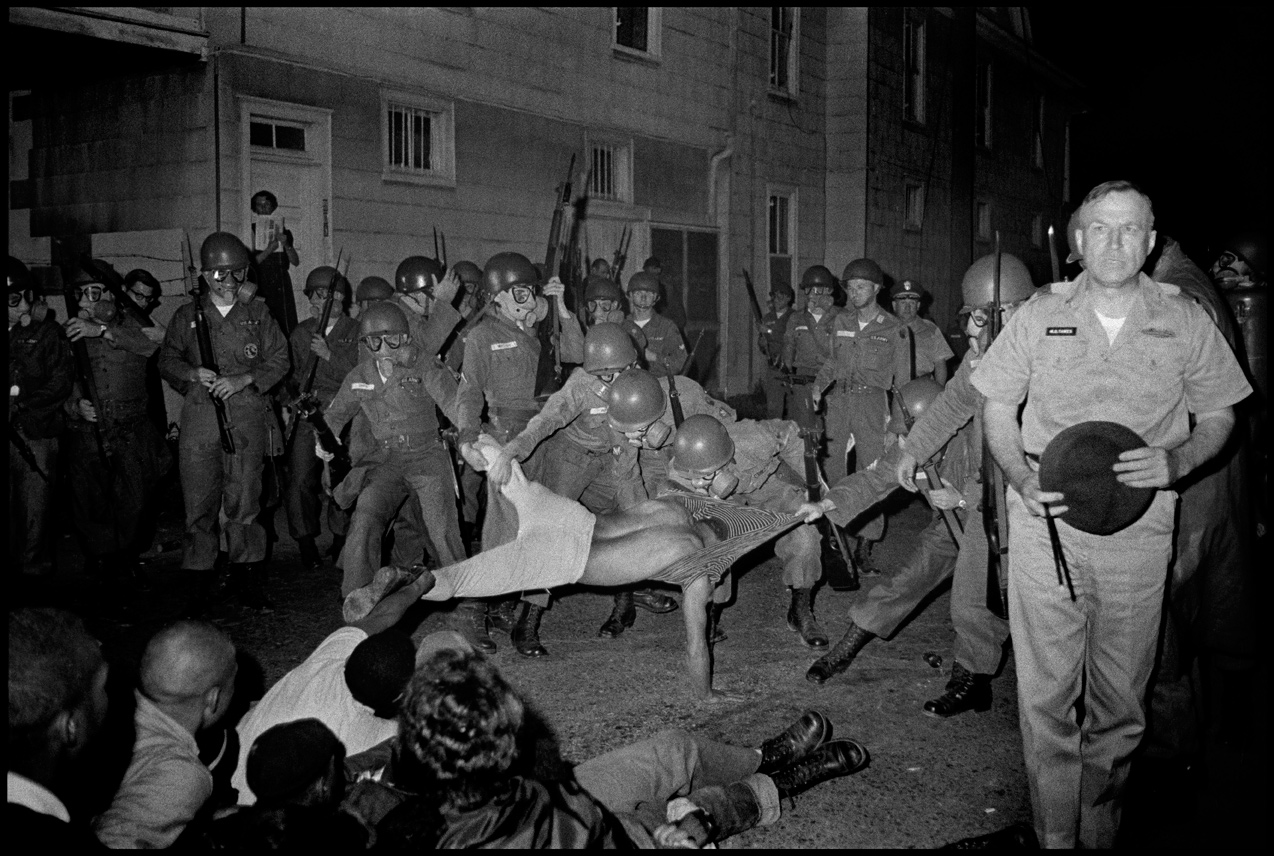Photography Department

Segregated drinking fountains at the Albany Courthouse, 1962, Danny Lyon, Memories of the Southern Civil Rights Movement 31, dektol.wordpress.com
When Danny Lyon went down to Albany, Georgia in August 1962, SNCC’s Executive Secretary Jim Forman saw an opportunity. “You got a camera?” he asked Lyon, “Go inside the courthouse. Down at the back they have a big water cooler for whites and next to it a little bowl for Negroes. Go in there and take a picture of that.” Armed with a Nikon F, Lyon, a history student at the University of Chicago, became SNCC’s first staff photographer.
As SNCC grew into itself as an organization, photographer became department, and “SNCC Photo” expanded to include people like Tamio Wakayama, Clifford Vaughs, Geoffrey Clark, Herbert Randall, Doug Harris, Bob Fletcher, Maria Varela, and Julius Lester. Working hand-in-hand with SNCC’s Communication Department, SNCC Photo helped define the southern Movement. “Public awareness was crucial to our strategy,” remembered SNCC’s Mary King, “Without national exposure and mobilized public opinion, there was no point to the struggle. The sacrifice would be lost in oblivion.”
The photography department’s mission was multi-fold. It relayed uncontestable visual information about the Movement, provided materials for organizing, and acted as a tool for fundraising, as well as worked to capture the “meaningful details of everyday life.” SNCC’s photos documented lived experiences, from rural life to political organizing, and provided stark proof of the brutality of racist violence that those in the Movement faced. The “pictures became organizers…” said Julian Bond, SNCC’s Communications Director, “[they] showed what we did and how we did it and who we were and who we worked with and where the work was done.”

Clifford Vaughs, SNCC photographer, is arrested by National Guard in Cambridge, Maryland, Spring 1963, Danny Lyon, Memories of the Southern Civil Rights Movement 138-139, dektol.wordpress.com
Documenting the Movement was no easy task. Photographers worked under combat-like conditions, constantly traveling and risking their lives. “Terrifying encounters became ‘normal’ to those of us working in the movement,” remembered SNCC photographer Maria Varela, “We learned how to overcome the paralysis of fear and developed finely tuned survival senses we never knew we had.” Matt Herron, organizer of the Southern Documentary Project, recognized that “if we got arrested and/or lost our film, we had failed at our job…we lied, we used fake press credentials, toadied up to police, or pretended to be someone else—all in the service of our cause.”
When equipment was destroyed, through violent encounters, dust, or overuse, SNCC photographers often reached out to supporters, like Marty Forsher’s Professional Camera Repair in New York. They sent the “battered beauties” to Forsher, who fixed and returned them free of charge. Photographers Richard Avedon, Herb Kratovil of Businessweek, and others helped create a network for SNCC Photo that helped provide photography and darkroom training, as well as disseminating SNCC’s images on a national scale.
Photos by SNCC photographers were used in exhibits, brochures, posters, newspapers, and even on the Senate floor. To make this possible, SNCC Photo had to develop a system to take care of the many steps in film processing, printing, and storage and find a way to become self-sustainable. By the mid-sixties, SNCC had darkrooms in Atlanta, Jackson, and Selma that would help process material for SNCC’s own publications and the requests they received from national and international news agencies. However, the demand on SNCC Photo was great, and the darkrooms were often understaffed and under-equipped to handle the quantity and quality of the requests.
In addition to bringing these perspectives of the Movement to the world, the photography department generated materials that were used in the field itself. They worked to get cameras into the hands of local people and developed filmstrips that allowed people to create, learn, and organize through photography. “The local people who have expressed a desire to construct materials,” said Varela, “are learning that their point of view and their own expression is valuable in that it tells the story more expressively and in a generally more useful way.” With this material, a farmer in Holmes County, Mississippi, could learn about the West Batesville Farmers Cooperative or the Delano Grape Strike and think about what that kind of organizing would look like in their hometown.
Photography through the lens of SNCC activists and local people made the personal political, as communities actively sought to redefine their conditions and fight for economic, psychological, and political liberation. It combated racist media coverage, was emotionally and visually evocative, and worked to illustrate the facts. As Forman put it, “Our actions centered around the idea of putting the federal government on the spot by assaulting the contradictions between federal law and American reality.” Photography was one way of doing just that.
Sources
Leslie Kelen, ed., This Light of Ours: Activist Photographers of the Civil Rights Movement (Jackson: University of Mississippi Press, 2011).
Mary King, Freedom Song (New York: William Morrow and Company, Inc., 1987).
Danny Lyon, Memories of the Southern Civil Rights Movement (Chapel Hill: University of North Carolina Press, 1992).
Leigh Raiford, “Come Let Us Build a New World Together,” American Quarterly, December 2007, 1129-1157.
Iris Schmeisser, “Camera at the Grassroots: The Student Nonviolent Coordinating Committee and the Politics of Visual Representation,” The Civil Rights Movement Revisited: Critical Perspectives on the Struggle for Racial Equality in the United States (New Brunswick: Transaction Publishers, 2001), 105-126.
Norris McNamara, “A Proposal for Meeting the Needs of the Photography Department of the Student Nonviolent Coordinating Committee,” April 1964, SNCC Papers, ProQuest History Vault.
Clifford Vaughs, “Field Report for Period of November 10 thru 17, 1964,” SNCC Papers, ProQuest History Vault.
Memo to Executive Committee from Tamio Wakayama, undated, SNCC Papers, ProQuest History Vault.
Proposal for use of Visual Education materials in CDGM Programs, May 16, 1966, SNCC Papers, ProQuest History Vault.
"Proposal for a Documentary Program in Photography," undated, Civil Rights Movement Veterans Website, Tougaloo College.






